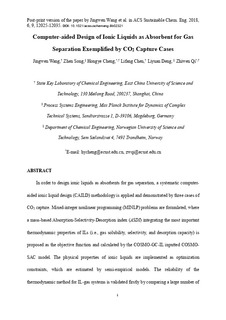| dc.contributor.author | Wang, Jingwen | |
| dc.contributor.author | Song, Zhen | |
| dc.contributor.author | Cheng, Hongye | |
| dc.contributor.author | Chen, Lifang | |
| dc.contributor.author | Deng, Liyuan | |
| dc.contributor.author | Qi, Zhiwen | |
| dc.date.accessioned | 2019-04-01T09:17:54Z | |
| dc.date.available | 2019-04-01T09:17:54Z | |
| dc.date.created | 2018-08-08T11:47:22Z | |
| dc.date.issued | 2018 | |
| dc.identifier.citation | ACS Sustainable Chemistry and Engineering. 2018, 6 (9), 12025-12035. | nb_NO |
| dc.identifier.issn | 2168-0485 | |
| dc.identifier.uri | http://hdl.handle.net/11250/2592649 | |
| dc.description.abstract | In order to design ionic liquids as absorbents for gas separation, a systematic computer-aided ionic liquid design (CAILD) methodology is applied and demonstrated by three cases of CO2 capture. Mixed-integer nonlinear programming problems are formulated, where a mass-based Absorption-Selectivity-Desorption index (ASDI) integrating the most important thermodynamic properties of ILs (i.e., gas solubility, selectivity, and desorption capacity) is proposed as the objective function and calculated by the COSMO-GC-IL inputted COSMO-SAC model. The physical properties of ionic liquids are implemented as optimization constraints, which are estimated by semiempirical models. The reliability of the thermodynamic method for IL-gas systems is validated first by comparing a large number of experimental and calculated data of Henry’s law constant of different gases in ILs. Then, comparative CAILD studies are performed for CO2 separation from flue gas (CO2/N2) to demonstrate the importance of ASDI for identifying practically attractive ILs. Afterward, the developed method is applied to design IL solvents for the separation of CO2 from syngas (CO2/H2) and sour gas (CO2/H2S). The correspondingly designed ILs for each case ([OAc]− and COOH-functionalized pyridinium for CO2/H2 and CO2/N2; [AlCl4]− and long branched alkyl substituted pyridinium for CO2/H2S) are analyzed from the σ-profile point of view. | nb_NO |
| dc.language.iso | eng | nb_NO |
| dc.publisher | American Chemical Society | nb_NO |
| dc.title | Computer-Aided Design of Ionic Liquids as Absorbent for Gas Separation Exemplified by CO2 Capture Cases | nb_NO |
| dc.type | Journal article | nb_NO |
| dc.type | Peer reviewed | nb_NO |
| dc.description.version | acceptedVersion | nb_NO |
| dc.source.pagenumber | 12025-12035 | nb_NO |
| dc.source.volume | 6 | nb_NO |
| dc.source.journal | ACS Sustainable Chemistry and Engineering | nb_NO |
| dc.source.issue | 9 | nb_NO |
| dc.identifier.doi | 10.1021/acssuschemeng.8b02321 | |
| dc.identifier.cristin | 1600401 | |
| dc.description.localcode | © American Chemical Society 2018. This is the authors accepted and refereed manuscript to the article. Locked until 17.7.2019 due to copyright restrictions. | nb_NO |
| cristin.unitcode | 194,66,30,0 | |
| cristin.unitname | Institutt for kjemisk prosessteknologi | |
| cristin.ispublished | true | |
| cristin.fulltext | postprint | |
| cristin.qualitycode | 1 | |
